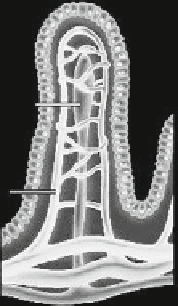Environmental Engineering Reference
In-Depth Information
The main factors that control the release of contaminants are discussed in the
following sections. The amount of contaminant liberated from the soil is considered
to be the maximum amount that is potentially available for absorption. This is called
the bioaccessible fraction
. The accessible fraction is produced mainly in the upper
part of the digestive tract, particularly in the stomach compartment, in the case of
metals. The extent to which ingested contaminants are rendered accessible depends
of physicochemical conditions in the digestive tract, as well as of transit time. Both
are modulated by the presence of food and soil in the digestive tract. The differences
between fed and fasted states are:
•
The presence or absence of food;
•
The amount of enzymes such as bile in the intestinal fluid (these can be very
different in the fed and fasted states); and
•
The pH conditions under which the model is employed (when food is present the
stomach pH is much higher).
Under fed conditions, the model should include an estimate of the nutritional
status of the receptor under investigation (for the RIVM fed state model, baby food is
included), an increase in the stomach pH and an alteration in the amount of enzymes
included in the test system (some are increased, such as the amount of bile added,
but others decreased) (Versantvoort et al.
2004
).
7.1.1.2 Absorption
Absorption occurs predominantly in the small intestine. This is a highly developed
organ with a large surface area specifically for this purpose. The walls of the small
intestine comprise of finger-like projections, of about one millimetre long, called
villi, which are in turn covered by numerous micro-villi as shown in Fig.
7.3
.
The villus contain blood and lymphatic capillaries, which transport nutrients, and
for the purposes of this discussion, contaminants to the rest of the human body.
Enterocytes (absorptive cells, which are predominantly responsible for absorption
Fig. 7.3
Intestinal villi,
finger-like projections of
about 1 mm long










Search WWH ::

Custom Search